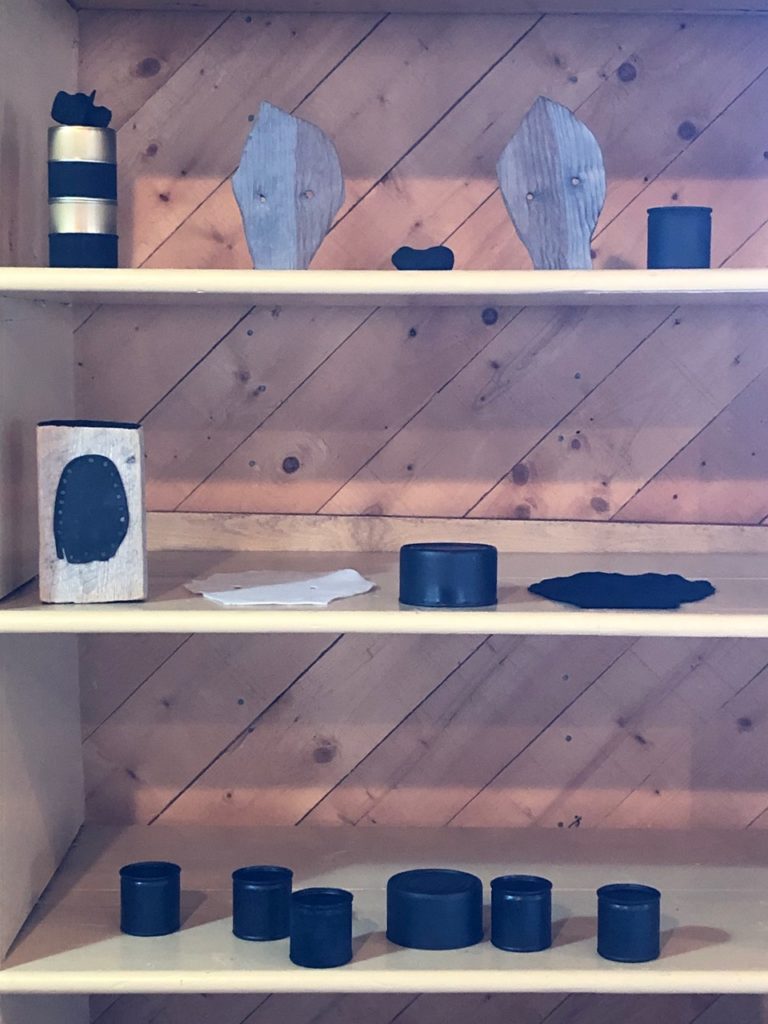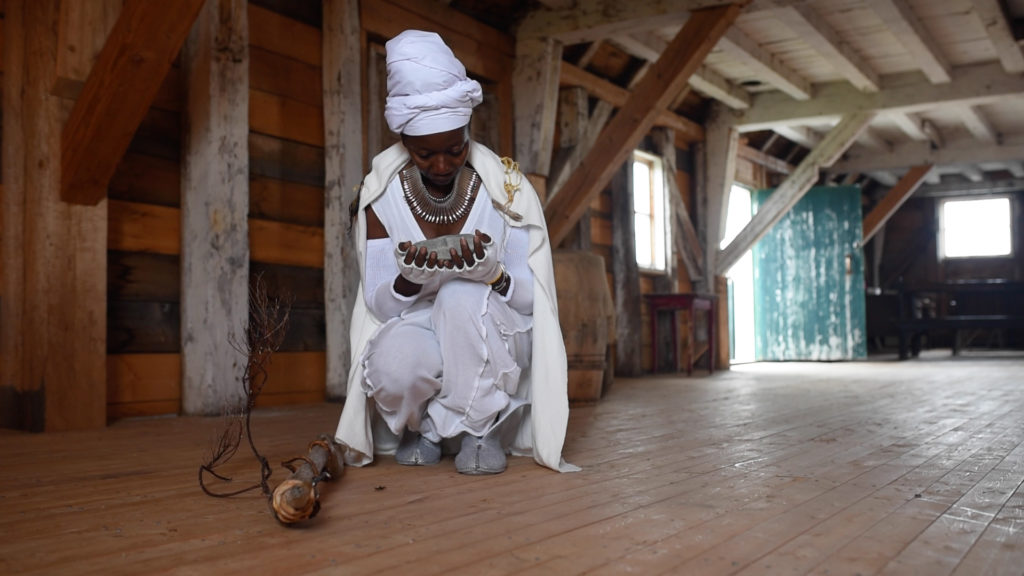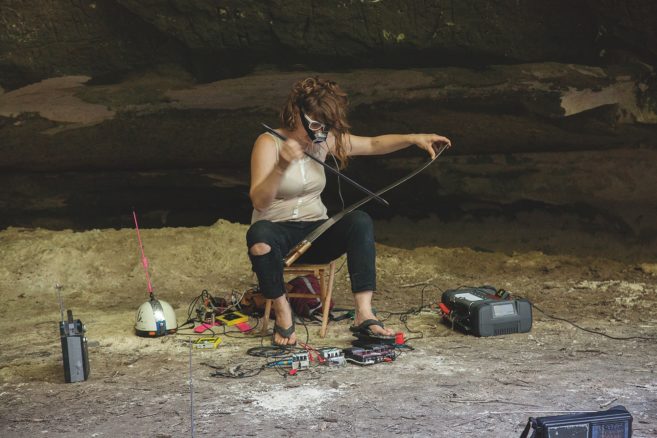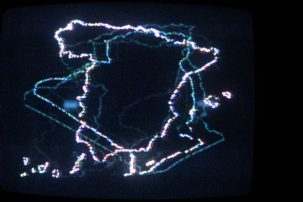Geographer Yi-Fu Tuan once defined place as “a center of meaning constructed by experience”—an ethos that resonated at the core of this year’s Bonavista Biennale. The multi-site exhibition spanned a 100-kilometre loop along the Bonavista Peninsula on the east coast of Newfoundland, a three-hour drive from St. John’s. The month-long event’s second iteration (which closed in September) took on the theme of “FLOE.” Co-curated by Catherine Beaudette, David Diviney and Matthew Hills, the exhibition highlighted Newfoundland as a distinct and unique place: seemingly isolated, yet historically the nexus of significant migratory and trade routes through mainland Canada, the US, the Caribbean and Europe.
“It exists as a sort of interstitial area between all of those places,” Matthew Hills, current director of Memorial University’s Grenfell Art Gallery in Corner Brook, shared with me. “There’s a tendency in Canada to see the East Coast as kind of peripheral, and in Newfoundland there’s a real sense that it’s actually really central in many ways.”
Taking its title from the word for a floating sheet of ice, “FLOE” both insists on this centrality as well as on fluidity. The exhibition brought together Indigenous and Canadian artists—most of whom have a connection to the island—as well as select US artists based along the north Atlantic seaboard, to contemplate place in rural Newfoundland and its connections to other locales, whether via water or land.
As a current student in curatorial studies and a mainlander coming to Newfoundland from Toronto, I was drawn to these rich and complex considerations of site-specificity as an experiment in using curatorial methods to remap understandings of space and place and critically decentre white-cubeness in exhibition-making. Working in the arts in the metropoles of Toronto or Montreal, one becomes biased by the rhetoric that the city is at the centre of all cutting-edge art and cultural production; such assumptions can construct asymmetries between the urban and the rural.
What can we learn from curating place- and land-based art in rural settings outside the white cube, featuring both regional as well as non-regional artists? The following is what I learned over the course of a three-week curatorial residency with the Bonavista Biennale, witnessing the benefits and challenges of curating projects within these settings, having conversations with the curatorial team, listening to artists, arts workers and audience members and riding along the peninsula road.
 Jerry Ropson_ water at the bottom of the ocean, rocks upon the shore (detail), 2018–19. Photo Brian Ricks.
Jerry Ropson_ water at the bottom of the ocean, rocks upon the shore (detail), 2018–19. Photo Brian Ricks.
 Jerry Ropson_ water at the bottom of the ocean, rocks upon the shore (detail), 2018–19. Photo Brian Ricks.
Jerry Ropson_ water at the bottom of the ocean, rocks upon the shore (detail), 2018–19. Photo Brian Ricks.
In its structure, the Biennale activated diverse sites across the peninsula—spanning historic grounds, heritage buildings and museums, underused public buildings as well as the natural landscape. What I didn’t expect was the powerful impact each of these installations had in responding to their environments, either by excavating histories of the island, paying tribute to the social fabric that links its inhabitants or providing meditations on the region’s landscape.
The installations hosted in the landmark town of Bonavista, at the tip of the peninsula, led the critical engagement with the area’s histories. On a wall on the outside of the former Bonavista Central High School and soon-to-be Wellness Centre, Jordan Bennett’s large-scale mural Pi’tawe’k (2019) marked the municipality, and the island as a whole, as Mi’kmaq and Beothuk territory. The work featured iconography from both cultures to intentionally create a visual reminder of the Indigenous histories of Ktaqmkuk as traditional unceded Mi’kmaq land. Atop a brightly painted backdrop, metal cutouts of highly reflective roadsign material depicted enlarged models of Beothuk caribou-bone pendants like those found across the island, as well as replicas of stars like those engraved in Conception Bay South and Kejimkujik, and an interpretation of a Beothuk canoe gliding along the river.
The use of roadsign material not only marked but asserted place, and, as Bennett explained during the opening weekend’s site tour, “show[s] our pathways,” signalling the ever-present and ongoing Indigenous legacies of the area. “This place was not discovered,” Bennett reminded the crowd during the tour, “no matter what the street names say.” Here Bennett references the 1497 landfall of Italian navigator Giovanni Caboto (better known as John Cabot) who, upon seeing Newfoundland’s landmass, is said to have exclaimed, “O buona vista!”—giving the region its colonial name.
 Meagan Musseau, Me’ki’tetmek na Maqmikewminen, 2019. Photo Brian Ricks.
Meagan Musseau, Me’ki’tetmek na Maqmikewminen, 2019. Photo Brian Ricks.
Narratives of place are often sustained by tensions between absence and presence; site-responsive work can reveal such tensions. Near Bennett’s mural, a one-to-one replica of the ship that Caboto sailed from Europe to North America is housed in the Ye Matthew Legacy site, celebrating the vessel and its role in colonial expansion. Along this same stretch of road by the town’s harbour, a largely unacknowledged part of the region’s naval history surfaced in Camille Turner’s installation at the historic Mockbeggar Plantation Fish Store. In this latest iteration of The Afronautic Research Lab (2016–), Turner drew attention to 19 slave ships built on the east coast of Newfoundland between 1751 to 1792 of which, unlike the Matthew, there is little to no documentation in the provincial archives. In the centuries-old fish store, a looped video depicted Turner embodying a figure from the year 2319, coming back to the present moment to speak of how an age of silence was lifted to give way to an age of reckoning. The installation, made up of traces left by this time traveller, functioned as a reading room containing texts about the context in which the ships were built—tools Turner provided to help collectively lift this silenced past.
There are ethics to any type of curating, especially outside of the gallery space. “Fundamentally—and I think this is key to any curatorial work—you want to align artists with site, with place, and with idea,” states co-curator Hills. “You want to seek those three in alignment and that’s key to any successful project. But for that to happen, you need to have an intimate, a real, respect for site, for place, and for the history of that place.” Part of that respect comes with responding to the complexities of an area, and providing platforms for the communities the project seeks to serve. Hills ultimately defines curatorial practice as public service.
 Camille Turner, Afronautic Research Lab, 2016–. Photo Brian Ricks.
Camille Turner, Afronautic Research Lab, 2016–. Photo Brian Ricks.
This sentiment is echoed in the creative and social practice of Bonavista-based Jane Walker, who was involved in the Biennale in multiple capacities—as artist, site attendant manager and lead administrator of Union House Arts (one of the 22 exhibition sites). The local community is central to Walker’s work—as in Elliston, where Walker and Barb Hunt collaborated on this slow loss reminds us to move (2019). An installation of salvaged synthetic flowers like those typically found at gravesites in Newfoundland were arranged in a single line to delicately circle the interior of St. Mary’s Church, spelling out the work’s title in Morse code. The concept emerged from a class Walker taught at a school in King’s Cove across the peninsula, where she discussed with junior high school students examples of loss, and again of hope, found within their own community. Many students talked about the steadily dwindling population in their area as a main source of loss. “I would not have been able to produce that work without that conversation with the students,” Walker tells me. “Because it’s about speaking with the community and not speaking at [them], or not making assumptions. It’s something you have to be delicate with when you’re putting art in a rural space.”
As site attendant manager, Walker recognizes the multiple intentions of the Biennale and therefore the diverse audiences it seeks to engage, including tourists to the area as well as specialized art enthusiasts. But as an organization relying on community support, “you need the people here to want it in order for it to even logistically happen.” Not only is the Biennale a local employer, it has also evolved into a catalyst for building community, “continu[ing] to build upon a body of knowledge that it’s creating in the region,” reflects Walker. “Something that I think is really valuable about the Biennale is how it pushes ideas and facilitates conversation in those [site-specific] contexts,” she shares, “in ways that would not happen otherwise.”
For instance, critical questions of who has access to land (and how) arose in D’Arcy Wilson’s installation in Duntara Community Hall. In two videos from her series #1 Fan (2016–), Wilson adopts the persona of “Nature’s #1 Fan” to query what mechanisms within her own settler culture allow her body to enter the landscape. In #1 Fan Drone (2019), a video filmed in the Bay of Islands, Wilson runs across dramatic vistas, waving a banner that reads “LUV U 4 EVR” intended for nature, yet her enthusiasm remains unreciprocated.
 Sean Partick O'Brien, Bergmál, 2019. Photo Brian Ricks.
Sean Partick O'Brien, Bergmál, 2019. Photo Brian Ricks.
An untitled intervention by Jerry Ropson considered how one literally enters the peninsula’s landscape, with handmade wooden signs installed along the peninsula’s main routes. Around the exhibition loop, Ropson’s painted signs could be mistaken for actual roadsigns, displaying conflicting messages such as “WITHIN REACH,” “JUST BEYOND REACH,” “JUST AHEAD” and “BETTER FORGOTTEN.” Here Ropson unframed the rural as a static, picture-perfect backdrop to be flattened and objectified, instead conveying rurality as a deeply complex logical system.
Site-specificity can perhaps be described as activating a collaboration between infrastructure, community and the land. Of course, all three elements interconnect, as embodied by Meagan Musseau in her powerful land-based performance Me’ki’tetmek na Maqmikewminen (2019), which launched the Biennale on its opening day. Musseau laboriously braided three large strands of red satin protruding from the earth, while artist Jenelle Duval sang and drummed, supplying the action its heartbeat. Musseau’s performance enacted an offering to the land, honouring the community and learning it sustains, and expressing gratitude for the gift of being in Ktaqmkuk.
When floes thaw in the springtime, they lose their shape but not their substance. Places are dynamic entities, neither monocultures nor static histories, and are perhaps best understood like the sea: in a constant state of flux. On my last day on the peninsula, I drove by another stunning harbour where the waves crashed against the rugged shore. Staked in the ground between the pavement and the edge of the cliff was another sign by Ropson. Its message, superimposed against the sea, read, “THIS TRUTH.”

 Anna Hepler, Mooring, 2019. Photo Brian Ricks.
Anna Hepler, Mooring, 2019. Photo Brian Ricks.







